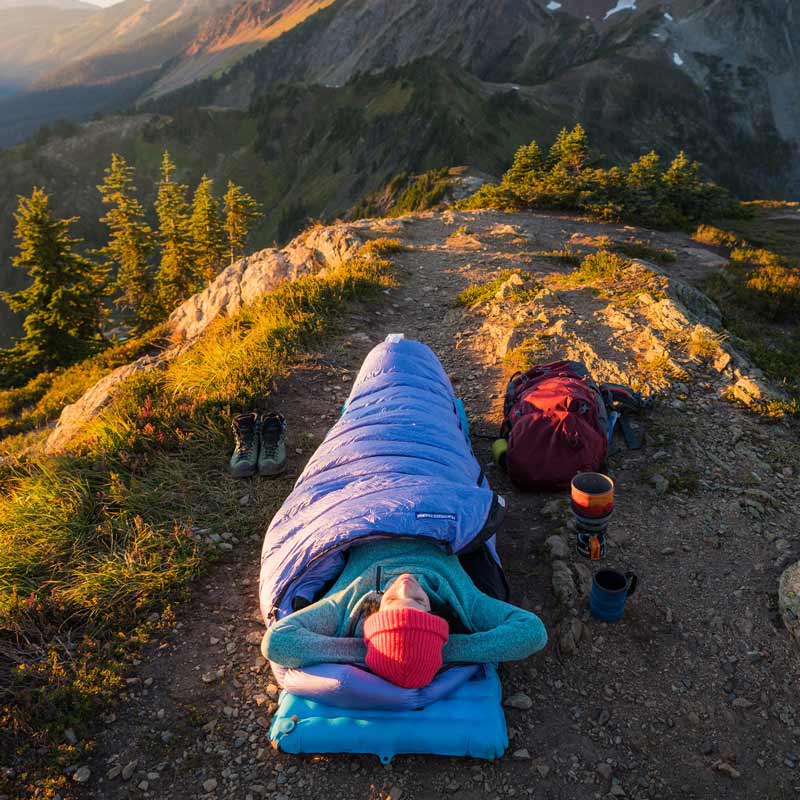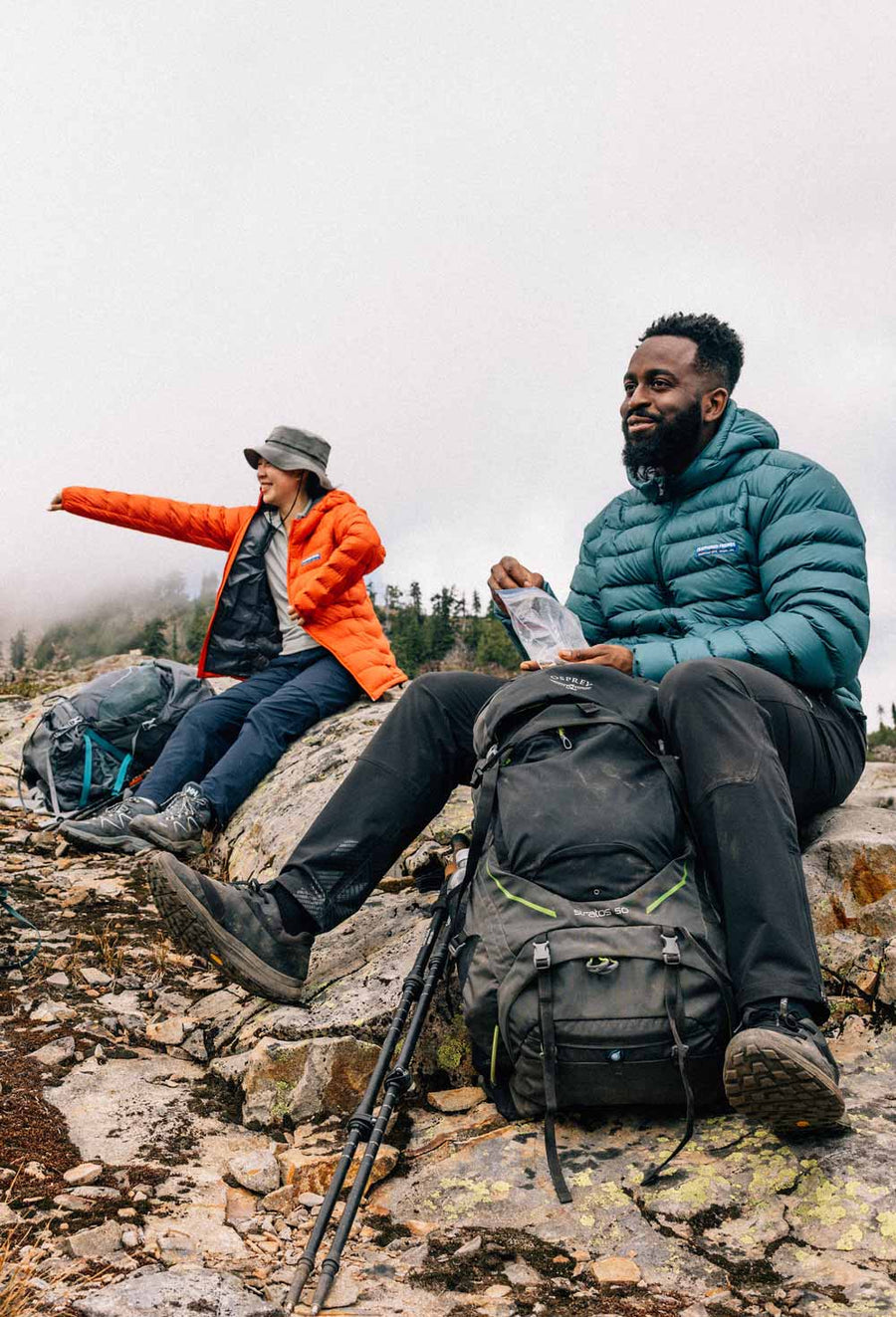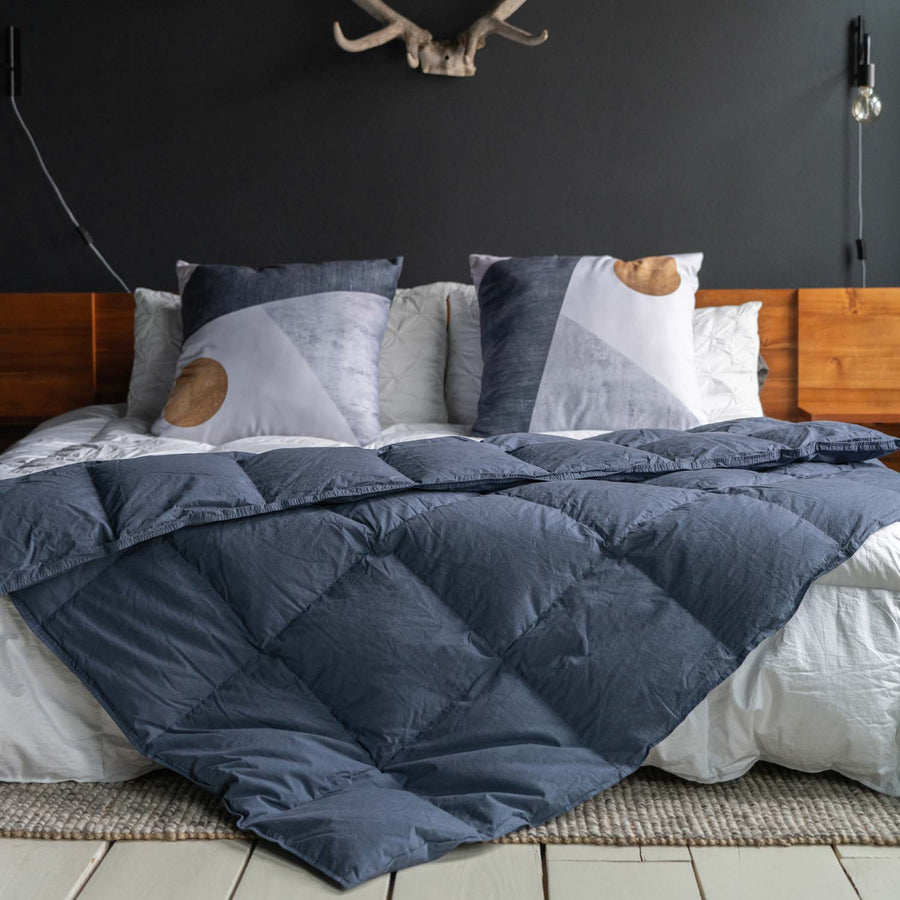Choosing A Sleeping Bag
Whether choosing a sleeping bag sounds exciting or daunting, you’re in the right place! A Feathered Friends sleeping bag will keep you warm and comfortable, pack down efficiently, and should last a decade or more if properly cared for. While there isn’t a single sleeping bag that can do everything, we have over 45 years of experience building, testing, and rating bags, and more than 50 sleeping bag models designed for everything from summer hikes to arctic expeditions that will keep you warm, wherever you are!
If you’re unsure where to start or are stuck between models, take a look at the quick guide below. If you’re still indecisive, are troubleshooting an unsuccessful past sleep system, or just want more information, continue on to the in-depth discussion that follows.
QUICK GUIDE
Temperature
Since you’re probably looking for a sleeping bag expressly in order to stay warm, it’s no surprise that temperature is the primary factor in selecting a sleeping bag that is right for you. As a rule, it’s a good idea to select a sleeping bag that is rated to a temperature slightly below what you expect to encounter. Hearty climbers and thru-hikers may be willing to utilize other insulating layers to extend the comfort range of their bags (or just be a bit more uncomfortable in order to save weight), while particularly cold sleepers may want to select a bag up to 20 degrees colder than the temperatures they anticipate experiencing. Although our sleeping bags are conservatively rated, many variables can affect your warmth -- take a look at the section below in order to assess your setup and adjust your temperature needs appropriately.
Shape
The shape of a sleeping bag plays an important role in both your overall comfort and in the thermal efficiency of your sleep system. While the roominess of a wide bag may feel more comfortable, particularly if you toss and turn at night, you’ll lose some of the optimal heat retention that comes with a bag that fits close to your body. Conversely, choosing a bag that is too narrow for your body shape in an attempt to shave weight will compress the down in your sleeping bag, creating cold spots (usually at the shoulder or hip). Aim for a bag that strikes the balance between comfort, weight, and thermal efficiency.
Length
This one’s easy! Look for a length that fits your height as closely as possible without compressing any down in the footbox or hood. That close fit will ensure that you’re not wasting energy warming empty air, helping your feet and head stay warm. If you’re looking at an expedition-weight bag and will need to stash extra gear in the footbox, size up.
IN-DEPTH
TEMPERATURE
When choosing a bag for an excursion, try to get an idea of what kind of temperatures you can expect to encounter -- the chart below shows average temperatures for popular destinations. Our bags are broken down into the following ranges:
- Three-season (40°F to 10°F): Three-season bags are some of the lightest sleeping bags we make and cover a wide range of warmer weather activities, from backpacking and thru-hiking to alpine climbing. Most three-season bags are offered in two different shell fabrics: Pertex® Quantum with YFuse (YF) and Ultralight Pertex® Quantum Pro® (UL). Check out our FAQs for more details.
- Winter (0°F to -10°F): Winter sleeping bags offer additional weather protection with a waterproof/breathable Pertex® Shield® fabric shell, and are perfect for snow camping and low-elevation ascents.
- Expedition (-25°F to -60°F): Built for the coldest of the cold, expedition sleeping bags are engineered to withstand weather conditions in some of the coldest regions on Earth. Expedition bags feature contoured shoulders, extra insulation in the draft collar, and side-block baffles (which maintain a 60:40 top to bottom insulation distribution) to seal out freezing temperatures.
When you have a solid understanding of what conditions you’ll be facing, assess all of the other factors that can impact your warmth, including:
-
Altitude: In addition to the temperature drop usually associated with high-altitude expeditions, elevation can have a huge effect on how effectively your body functions and recovers. At altitude (particularly during rest), breathing rate slows, blood thickens, and both heat and oxygen have a harder time circulating to extremities. Account for a dip in fitness if you’ll be consistently above 8,000 ft.
-
Gender: It’s old school (and by no means universal), but in general, we’ve found that women do sleep colder than men. Accordingly, our women’s bags contain a higher proportion of down than their unisex/men’s equivalents, including more down fill in the footbox.
-
Hunger and hydration levels: Just like energy, heat is generated by your body in proportion to how much fuel (food) you put in it. If you’ve ever slept hot after eating a big meal or felt enervated after a cold night, you’ve experienced the intimate -- and finite -- relationship between heat and energy. Give your body plenty of calories and stay hydrated if you want your best chance of staying warm in the cold. For an extra warmth boost, create friction heat by rubbing your hands and feet together, or get your metabolism revving by doing a couple of jumping jacks before you get into your sleeping bag. Remember: a bag only retains the warmth you bring with you, it doesn’t generate any of its own.
-
Layers: It’s tempting, on those really cold nights, to put on every item of clothing you have, but that philosophy may actually impede your warmth. To optimize heat convection, strip off any sweaty or wet clothing as soon as possible and put on a set of dry wool base layers. Target cold-prone areas like your toes and head with dry, clean socks (or some of our down booty liners) and a beanie. If you’re still cold, or if you are attempting to extend the range of one of our specialized sleeping bags, layer on a down jacket.
-
Cleanliness: No, not you, the bag! (Although we at Feathered Friends do recommend occasional bathing.) If you’ve used your sleeping bag a lot, dirt, moisture, and the oils from your skin can accumulate in your sleeping bag, decreasing the loft of the down and diminishing its insulating ability. Make sure to periodically wash your sleeping bag in accordance with our washing instructions
-
Tent or shelter: As simple as it may seem, camping in a tent or other enclosed shelter really is warmer. Shelters reduce the amount of heat lost through radiant, evaporative, and convective cooling by warming the air inside of the enclosed area.
- Sleeping pad: Aside from your sleeping bag, your sleeping pad is the most important piece in your sleep system. Sleeping pads prevent conductive heat loss to the cold ground beneath you by creating an air buffer that insulates your sleeping bag, which in turn insulates you. In some circumstances, you’ll lose more heat to the ground than to the air, so make sure your sleeping pad meets or exceeds the insulating power of your sleeping bag.
A note about continuous baffles:
All of our sleeping bags from 40°F to -10°F have continuous baffles, which means that the channels running horizontally across the bag run all the way around the bag, without any side baffles. If you'd like to alter the distribution of the down fill in your bag, you'll just need to give it a good shake! Unzip the bag, hold it by the side that has more down, and manually shake down into the bottom half (you can check distribution by holding your bag up to a strong light source). Keep in mind that any down beneath you while you sleep will not insulate, so if you want to equally distribute the down in your bag (if, for example, you toss and turn at night), it won't be quite as warm as if you pooled more of the down on top of you -- if you need to make your bag as warm as possible on a cold night, shake as much down as you can into the top half.
SHAPE
We provide the dimensions of our sleeping bags in a series of three or four numbers that should give you a good idea of the shape of the bag. Those measurements refer to the interior circumference of the sleeping bag, measured in inches, at the shoulder, elbow, hip, and foot.
Feathered Friends offers one of the widest varieties of sleeping bag shapes on the market. The chart below shows the interior measurements for each of our sleeping bag styles, including some specialty bags.
20/30 Degree Bags
| Bag Width | Model | Shoulder (in) | Elbow (in) | Hip (in) | Foot (in) |
|---|---|---|---|---|---|
| Narrow Mummy | Hummingbird 20/30 | 56.5 | 60 | 52.5 | 40.5 |
| Standard Mummy | Swallow 20/30 | 58.75 | 64 | 54.75 | 41.5 |
| Wide Mummy | Swift 20/30 | 60.5 | 68 | 56.75 | 43.5 |
| Women's Mummy | Egret 20/30 | 56.75 | 62 | 58.75 | 40.5 |
10 Degree Bags
| Bag Width | Model | Shoulder (in) | Elbow (in) | Hip (in) | Foot (in) |
|---|---|---|---|---|---|
| Standard Mummy | Lark 10 | 58.75 | 64 | 54.75 | 41.5 |
| Wide Mummy | Raven 10 | 60.5 | 68 | 56.75 | 43.5 |
| Women's Mummy | Petrel 10 | 56.75 | 62 | 58.75 | 40.5 |
0 Degree Bags
| Bag Width | Model | Shoulder (in) | Elbow (in) | Hip (in) | Foot (in) |
|---|---|---|---|---|---|
| Standard | Snowbunting 0 | 57 | 64 | 53 | 38 |
| Wide | Ibis 0 | 59 | 68 | 55 | 40 |
| Women's | Murre 0 | 55.5 | 62 | 57 | 37 |
| Differential Cut for 0 Degree Bags: 1" (4" Total) | |||||
-10 Degree Bags
| Bag Width | Model | Shoulder (in) | Elbow (in) | Hip (in) | Foot (in) |
|---|---|---|---|---|---|
| Standard | Widgeon -10 | 57 | 64 | 53 | 38 |
| Wide | Eider -10 | 59 | 68 | 55 | 40 |
| Women's | Arctic Finch -10 | 55.5 | 62 | 57 | 37 |
| Differential Cut for -10 Degree Bags: 1.5" (6" Total) | |||||
-25 Degree Bags
| Bag Width | Model | Shoulder (in) | Elbow (in) | Hip (in) | Foot (in) |
|---|---|---|---|---|---|
| Standard | Ptarmigan -25 | 57 | 64 | 53 | 38 |
| Wide | Peregrine -25 | 59 | 68 | 55 | 40 |
| Women's | Plover -25 | 55.5 | 62 | 57 | 37 |
| Differential Cut for -25 Degree Bags: 2" (8" Total) | |||||
-40 & -60 Degree Bags
| Bag Width | Model | Shoulder (in) | Elbow (in) | Hip (in) | Foot (in) |
|---|---|---|---|---|---|
| Wide | Snow Goose -40 | 64 | - | 60 | 39 |
| Wide | Snowy Owl -60 | 64 | - | 60 | 39 |
Specialty Bags
| Model | Shoulder (in) | Elbow (in) | Hip (in) | Foot (in) |
|---|---|---|---|---|
| Flicker | 62 | - | 48 | 39 |
| Flicker Wide | 67 | - | 55 | 40 |
| Tanager | 62 | 63 | 55 | 40 |
| Tanager Wide | 66 | 70 | 60 | 40 |
| Vireo | 66 | - | 48 | 38 |
| Spoonbill | 104 | - | 90 | 68 |
To determine your most efficient bag shape, start by measuring the circumference of your shoulders by wrapping a measuring tape all the way around your shoulders, including your arms. Your perfect sleeping bag width will be that shoulder measurement + 10”, plus or minus an inch or two. If, for example, your shoulders measure 54”, your ideal bag would have a shoulder measurement of 54” + 10” = 64” (the same applies for waist measurements, which should be taken at the hip). If you’re between widths, consider how you sleep (hot or cold, active or passive, zipped up or zipped open), and choose the bag that suits your sleeping style best.
LENGTH
Choosing a sleeping bag length that’s right for you is one of the easier decisions you’ll make, but it’s not always cut and dried. An appropriate length sleeping bag will give you enough room to be comfortable without sacrificing heat retention. Bags that are too long for your body will have more surface area for heat to escape, and more empty space that you will expend energy to heat. Our length measurements run from the hood to the footbox, and are pretty basic:
Men’s/unisex (left side zipper)
- Regular: 6’ (1.83m)
- Long: 6’6” (1.98m)
Women’s (right side zipper)
- Small: 5’3” (1.6m)
- Medium: 5’9” (1.75m)
Tanager and Vireo (no zipper)
- 68” (1.73m)
- 74” (1.88m)
For three-season use, we usually recommend the bag length that most closely fits your height. If you’re on the edge (say, 6ft or 1.83m tall) and are looking to keep the weight of your sleeping bag down, you should be able to size down comfortably into a regular length. If you like a little extra space, size up.
For cold weather use, where you might be using your sleeping bag to store temperature-sensitive items like electronics, fuel, water, clothing, or boot liners, be sure to choose a length that gives you extra space.
Double sleeping bags
The most efficient (and comfortable) way to share warmth is always to use a sleep system designed to accommodate two people. We offer a wide range of sleeping solutions for couples, including:
- Condor: This fully rectangular sleeping bag can be used alone as the roomiest single-person bag we make, or fully unzipped and attached to a matching groundsheet to create a sleeping bag for two. For colder nights, optional hoods can be zipped on to both the bag (if using as a single bag) or the groundsheet (if using as a double bag). The Condor groundsheet accommodates two 25” wide sleeping pads.
- Penguin: This semi-rectangular bag is built with all of the features of the Condor, without the extra bulk and weight of a fully rectangular footbox. Like the Condor, the Penguin fully unzips and attaches to a matching groundsheet and optional hoods to switch between one- and two-person configurations. The Penguin groundsheet accommodates two 20” wide sleeping pads.
- Flicker: This hybrid sleeping bag/quilt fully unzips into a quilt, which means that when you’re not using it alone, it can be zipped into another Flicker and cinched at the footbox to create a double version of the Flicker that will accommodate two people. Regular and Wide Flickers are all compatible, both with themselves and each other. Current Flickers do not have compatible zippers with Flickers made prior to 2023.
- Spoonbill: This award-winning design is the most specialized bag we make, and is the ultimate in weight savings and efficiency. The Spoonbill allows two people to share the thermal benefit of being in the same bag while maintaining the efficiency of independently contoured hoods and collars. To save weight, we’ve eliminated all insulation from the sleeping bag floor -- you’ll need to use two sleeping pads with a couple kit underneath, or cut a closed cell foam pad to fit the interior bag floor.
Because double sleep systems are so complex, we do not assign them temperature ratings. Use the down fill specification to get an idea of how warm a bag will feel, then compare it against your needs, experience, and tolerance for discomfort.
Linking bags
In an emergency, two mummy-style sleeping bags can be zipped together to conserve warmth, but the resulting system is rarely heat efficient -- and even more rarely comfortable. If you have experience zipping two mummy bags together and would like to ensure that your and your partner’s bags will zip together, just be sure that one carries a left-hand side zipper (standard on all men’s/unisex bags), and the other carries a right-hand side zipper (standard on all women-specific bags). Keep in mind that if the bags you intend to zip together are two different lengths, they will only zip together as far as the shorter zipper will allow.
We use an industry standard #5 YKK zipper on our 3-season sleeping bags, but, due to slight changes in zipper construction over the years, we cannot guarantee that these will mate with other manufacturers’ bags or with older Feathered Friends models.







